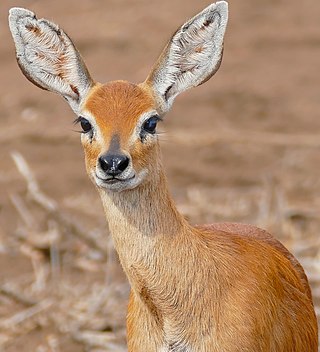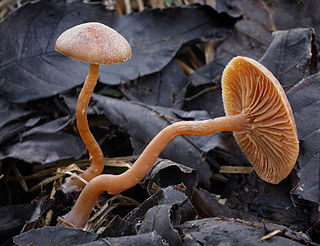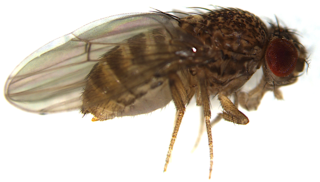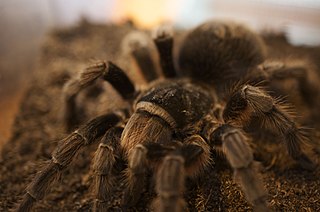
Raphicerus is a genus of small antelopes of the tribe Neotragini.
Erich Martin Hering was a German entomologist who specialised in leafmining insects, He was a curator in the Museum für Naturkunde in Berlin, where his collections of Lepidoptera, Coleoptera, Hymenoptera, Diptera are conserved. His collections of Agromyzidae are shared between MfN and the Agricultural School at Portici now part of the University of Naples Federico II.

The Bionectriaceae are a family of fungi in the order Hypocreales. A 2008 estimate places 35 genera and 281 species in the family. Species in the family tend to grow on plant material, including woody debris, while some species associate with algae, bryophytes, or other fungi.

Nectriopsis is a genus of fungi in the class Sordariomycetes. The number of species in this genus varies between sources. The Dictionary of Fungi lists only 58 species, but the Catalogue of Life includes 72 species.
Urceolella is a genus of fungi within the Hyaloscyphaceae family. The genus contains 23 species. Species Fungorum accepts 44 species.

Disciseda is a genus of gasteroid fungi in the family Agaricaceae. It is a widely distributed genus that is prevalent in arid zones. Disciseda was circumscribed by mycologist Vassiliĭ Matveievitch Czernajew in 1845.

Lenzites is a widespread genus of wood-decay fungi in the family Polyporaceae. It was circumscribed by Elias Magnus Fries in 1835. The generic name honours German naturalist Harald Othmar Lenz (1798–1870).

Tubaria is a genus of fungi in the family Tubariaceae. The genus is widely distributed, especially in temperate regions. Tubaria was originally named as a subgenus of Agaricus by Worthington George Smith in 1870. Claude Casimir Gillet promoted it to generic status in 1876. The mushrooms produced by species in this genus are small- to medium-sized with caps ranging in color from pale pinkish-brown to reddish-brown, and often with remnants of the partial veil adhering to the margin. Mushrooms fruit on rotting wood, or, less frequently, in the soil. There are no species in the genus that are recommended for consumption.

Ramularia is a genus of ascomycete fungi. Its species, which are anamorphs of the genus Mycosphaerella, are plant pathogens. Economically important host species include Narcissus, sugar beet, and barley.
Glyptothorax alaknandi is a species of catfish that was first described by Tilak, 1969. Glyptothorax alaknandi is a species in genus Glyptothorax, family Sisoridae and order Siluriformes. IUCN categorise the species as least concern globally. No subspecies are listed in Catalogue of Life.

Glyptothorax botius is a species of catfish that was first described by Hamilton 1822. Glyptothorax botius is a species in genus Glyptothorax, family Sisoridae and order Siluriformes. IUCN categorise the species as least concern globally. No subspecies are listed in Catalogue of Life.
Glyptothorax buchanani is a species of catfish that was first described by Smith, 1945. Glyptothorax buchanani is a species in genus Glyptothorax, family Sisoridae and order Siluriformes. IUCN categorise the species as insufficiently studied globally. No subspecies are listed in Catalogue of Life.
Glyptothorax callopterus is a species of catfish that was first described by Smith, 1945. Glyptothorax callopterus is a species in genus Glyptothorax, family Sisoridae and order Siluriformes. IUCN categorise the species as least concern globally. No subspecies are listed in Catalogue of Life.
Ogaridiscus is a genus of air-breathing land snails, terrestrial pulmonate gastropod mollusks in the family Zonitidae.

Drosophila mercatorum is a species of fruit fly in the genus Drosophila, repleta subgroup, described by Patterson and Wheeler in 1942. Thought to be native to South America, its subspecies D. m. mercatorum now has a cosmopolitan distribution. The other subspecies, D. m. pararepleta, is confined to the east of the Andes mountains.

Grammostola alticeps is a New World spider in the tarantula family (Theraphosidae). It is endemic to Uruguay, Paraguay, and Brazil.

Sphoeroides greeleyi is a fish species described by Charles Henry Gilbert in 1900. Sphoeroides greeleyi is part of the genus Sphoeroides and the pufferfish family Tetraodontidae. No subspecies are listed in the Catalog of Life.

Cupes capitatus is a species of beetle described by Johan Christian Fabricius in 1801. It is the only living species in the genus Cupes within the family Cupedidae. It is found in North America, in the United States from Georgia to Maine and in Canada in Ontario.
Dasychalina fragilis is a species of sponge described by Stuart Oliver Ridley and Arthur Dendy in 1886. Dasychalina fragilis belongs to the genus Dasychalina and the family Niphatidae.












